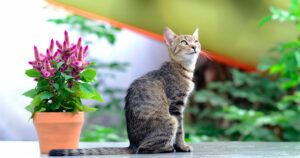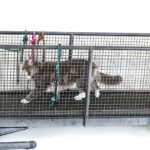Kittens are known for being energetic, playful, and curious creatures. One of their most common activities is jumping – you’ll often see kittens leaping on and off furniture, scaling cat trees, and exploring their environment from new heights. But just how high can a kitten jump?

The jumping ability of kittens is quite impressive considering their small size. Most kittens can safely jump to heights of 2-3 times their body length. So for an average 8-10 inch long kitten, that means a vertical jump of 16-30 inches is well within their range. With enough momentum, some athletic kittens can even reach heights of 3-4 feet at just 2-3 months of age!
Factors That Determine a Kitten’s Maximum Jumping Height
Not all kittens are created equal when it comes to their maximum jumping reach. Many factors play a role in determining how high your kitten can leap.
Age
Age is one of the biggest determinants of a kitten’s jumping ability. As kittens grow, their leg muscles get stronger and their coordination improves dramatically.
While most kittens can only manage small hops at 8 weeks old, by 5-6 months they are making much more impressive vertical leaps. Their full adult jumping ability is achieved once their growth plates close at around 1 year old.
Here’s a breakdown of how kittens’ average jumping height expands with age:
- 8 weeks: 1 foot
- 3 months: 2 feet
- 6 months: 3 feet
- 9-12 months: Full adult jumping height of 4-5 feet
So if your kitten is still perfecting walking and climbing skills, you can expect small hops and falls. But in just a matter of months, they will progress to leaping onto counters, fridges, and high shelves with ease.
Breed
Some cat breeds are naturally more agile and athletic than others. Breeds like the Bengal and Savannah tend to have strong jumping abilities, thanks to their wildcat ancestry.
The Munchkin cat, on the other hand, is limited by its short legs and likely won’t be breaking any vertical leaping records.
In general, lighter cats will be able to jump higher than heavier cats. So Siamese and Balinese cats often make exceptional jumpers due to their lean build.
Health
A kitten’s overall health impacts their physical abilities, including jumping. An injured or sick kitten will not be able to jump as high as a healthy kitten.
Any conditions that affect mobility, such as arthritis or ligament injuries, will limit how high and frequently a kitten can jump. Kittens that are overweight or obese may also struggle to get good vertical lift.
Environment
Kittens raised in environments that encourage climbing and jumping from a young age will develop stronger jumping skills.
Providing adequate vertical space, cat towers, toy motivation and safe landing surfaces will all help your kitten expand their vertical leaping limits. Lack of opportunities, confinement or restrictive spaces may curb a kitten’s natural jumping development.
Strength & Coordination
As kittens grow, the strength of their hind limb muscles and their overall balance and coordination directly impact jumping ability. Kittens around 5-7 months old go through rapid improvements in strength, flexibility and agility that really boost their jumping reach.
Individual variation in these physical traits means some kittens will master higher leaps earlier than others. But with proper exercise and training, all healthy kittens eventually build the necessary muscle tone and neuromuscular control to jump with precision.
Personality
Daredevil kittens that are bold, playful and eager to climb will likely jump higher than cautious kittens.
A kitten’s motivation to chase prey or toys upward also influences their willingness to push their physical limits. Shy, lazy or timid kittens may never jump as high simply because they lack the confidence and drive.
Genetics
Like humans, some kittens are simply born star athletes. If your kitten’s parents were champions at jumping, leaping and climbing, there’s a good chance your kitten inherited some natural athleticism too.
Breeding plays a role, but even within a litter there can be significant variation in energy levels, coordination and boldness that translate to how high kittens jump.
Tips for Safely Developing Your Kitten’s Jumping Skills
Kittens learn by doing. By providing a safe, stimulating environment for your kitten to jump and climb, you can promote healthy development of their muscles, balance and coordination.
Here are some tips for encouraging your kitten’s natural jumping abilities without putting them in harm’s way:
Start low and provide support
Kittens first start jumping and climbing around 6-8 weeks of age. But their movements are unsteady and awkward at this stage.
Start by providing sturdy, low surfaces for your kitten to jump on and off of. Keep their initial jumping experiences close to the ground and provide nearby furniture, walls or your hands for support if needed.
Invest in a cat tree
A sturdy cat tree with different platform heights provides endless jumping opportunities. Make sure to choose one with scratching posts and toys on each level to motivate your kitten to climb and jump.
Place the cat tree near furniture or windows to inspire adventurous leaps across spaces. Just be sure to keep breakables and valuables out of paw’s reach!
Use treats as training tools
Hide treats on elevated surfaces or dangle them from above to encourage your kitten to jump upward. Start low and gradually increase height as their skills progress.
You can also motivate jumping by throwing treats horizontally for them to chase after. Just make sure to avoid excessive treats, as you don’t want an overweight kitten struggles with jumping down the road.
Key Takeaway: Sturdy cat trees, dangling treats, and patience help kittens develop jumping skills safely.
Provide soft landing spots
While cats can absorb impacts well, kittens’ growing bones and joints are vulnerable to injury from big falls and awkward landings.
Provide soft rugs, cushions or folded blankets below their favorite jumping spots to cushion any tumbles. And avoid hard surfaces like tile or wood floors for high kitten jumps.
Check your kitten’s limits
Pay attention to your kitten’s coordination, balance, and confidence at different heights. Intervene if they seem hesitant or are struggling to stick their landings.
While encouraging gradual progress, don’t push your kitten to jump beyond their current abilities or tolerance. Let their skillset expand at a natural pace.
Testing Your Kitten’s Verticle Limits
As your kitten masters their core jumping skills, you can start to test just how high they can go!
Here are some fun ways to measure your kitten’s vertical limits:
Lure them upwards
Hold a feather toy or laser light at increasing heights and see how far up your kitten will jump to swat at it. Just make sure a soft landing surface is in place in case they miss on the way down!
Arrange box stairs
Place boxes or cushions in stair-step fashion and see how high your kitten will climb and leap from one to the next. Start low and increase height gradually as they improve.
Dangle toys from doorknobs
Tie a favorite toy from a sturdy string and hang it from a raised doorknob or ceiling hook at different heights. Encourage your kitten to jump for it. This is a great way to test leaping improvement over time.
Hoops and hurdles
Set up homemade hurdles or hanging hoops and watch your kitten’s vertical skills as they try to clear new heights. Just be sure hoops are very lightweight and any hurdles have a soft landing zone.
Measure the highest reach
Mark a wall in inch increments and encourage your kitten to jump for toys at increasing heights. Reward them with treats for any new personal bests! This helps track their progress.
When to Be Concerned About Your Kitten’s Jumping
While jumping is a normal kitten behavior, in some scenarios it can be a cause for concern. Be on the lookout for any of these signs:
Avoiding jumps they used to make easily
If your once-confident jumping kitten seems reluctant to make leaps they previously managed with no problem, joint pain or injury may be holding them back. Have your vet examine them.
Misjudging distances
Kittens learn spatial judgement as they gain experience. But if your kitten is consistently miscalculating jumps, it could signal vision issues. Consult your vet right away.
Regressing in skills
If your kitten seems suddenly unable to jump as high or land as gracefully, it may point to an underlying medical condition affecting their mobility or balance. Seek veterinary advice.
Key Takeaway: Avoiding jumps, misjudging distances, or losing skills warrant a veterinary check-up.
Obsessive jumping
While kittens are normally energetic, obsessive or destructive jumping may indicate boredom, stress or anxiety needs addressing. Try more interactive playtime and mental stimulation.
Falling frequently
If your kitten keeps falling off elevated surfaces, they may be attempting dangerous jumps beyond their current ability. Limit access to high surfaces and provide more supervision during play.
By tuning into changes in your kitten’s jumping habits and abilities, you can get them medical care for any issues and modify their environment to set them up for safe success.
Cat-Proofing Your Home for High-Flying Kittens
The phrase “curiosity killed the cat” exists for a reason – kittens will leap and climb anywhere their little hearts desire. Here are some tips to cat-proof your home against gravity-defying kittens:
Use sticky shelves
Apply double-sided sticky tape along the edges of bookshelves, counters, tables and any other surface you want to deter jumping onto. Most kittens avoid the unpleasant sticky sensation on their paws.
Block access
Keep kittens away from potential fall hazards like balconies, open windows and lofts by installing pet gates or mesh screens to block access.
Install window perches
Give your curious kitten a safe view from windows by installing sturdy cat perches on the sills. They can look outside without risking window falls.
Strategically place cushions
Place cushions, pillows and thick rugs below your kitten’s favorite jumping spots to prevent injuries from any miscalculated leaps.
Keep your eye on the prize
When introducing your kitten to new environments, scope out any potential dangers and risky jumping opportunities in advance. Even the best cat-proofing can’t beat proactive supervision!
FAQs
How high can an 8 week old kitten jump?
Most 8 week old kittens can only safely manage small hops of about 1 foot high. Their leg muscles are still developing at this age. With their clumsy coordination, it’s best to keep them on low furniture and not encourage any big jumps.
Should I stop my kitten from jumping?
You should not completely stop or deter your kitten from jumping, as this is an important developmental activity for them. Instead, focus on redirecting your kitten to safe and appropriate jumping spots, like cat trees. Limit access to dangerously high surfaces only.
How do I know if my kitten’s jumping is too high?
Pay attention to any crashing, falling, or awkward landings from your kitten’s jumps. If they seem to be miscalculating distances or struggling to stick their landings, intervene and limit their jump height by moving furniture or blocking access. Proper form and control should match their vertical progression.
Can a 3 month old kitten jump on a bed?
Yes, a 3 month old kitten can likely manage the jump onto an average bed height of 2-3 feet. But kittens develop at different paces. Make sure to provide a soft landing surface on the bed and monitor your kitten’s ability to judge the distance and stick the landing.
At what age can kittens jump their highest?
Kittens reach their full adult jumping heights around 9-12 months as their growth plates close and muscles fully develop. But impressive improvements happen each month from 3 months onward. Most are making 3-4 foot vertical leaps by 6 months old.
Conclusion
Kittens are blessed with a stunning vertical leap that lets them explore the world from new heights starting at just 2 months old. With proper training, cat-friendly homes, and attentive supervision, you can nurture your kitten’s natural jumping prowess while keeping their adventures safe and fun.
Watching your kitten master gravity-defying leaps is incredibly rewarding. Just be sure to give them time to develop coordination and spatial judgement, provide soft landings, and redirect any overly zealous jumping tendencies. With the right care, your tiny kitten will be launching onto refrigerators and cat trees in no time!








